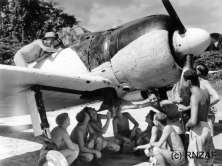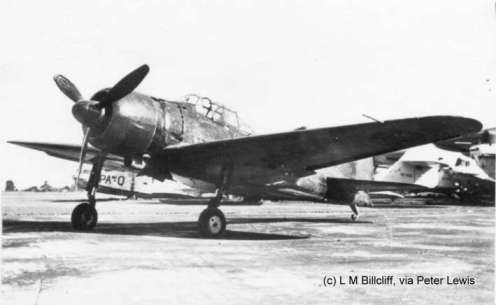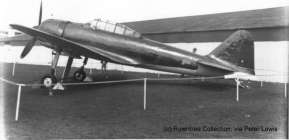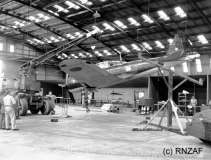Mitsubishi A6M Reisen
'Zero'
Aircraft Series

All text material on this site is
© Peter Lewis
1985, 1999
unless otherwise acknowledged

Colour Schemes
NZ6000 has worn at least five distinct colour schemes, as described in the following paragraphs:
Japanese Navy: The standard colours for JNAF combat
aircraft from July 1943 were dark green upper surfaces with light grey
(or natural metal) lower surfaces. Engine cowlings were black. Shiro
Imazawa, who worked on the machine, confirms that the aircraft was painted
in this manner, but with the addition of "green and grey spots here
and there... ", presumably an attempt at a blotch-type camouflage. The
red Hinomaru on both sides of the fuselage and on both upper and lower
wings were not outlined in white - a common omission in combat areas.
The aircraft identification data information was painted on the port
rear fuselage in black, and the unit/aircraft numbers 2-182 were painted
across the fin and rudder in a lighter colour (possibly white, red or
yellow). 
Surrender Markings: As specified by the Allied authorities, the dark paintwork had been covered with white (washoff?) paint. An unusual, and possibly unique, feature on this machine was that the top half of the engine cowl and the area extending back from this to and slightly behind the cockpit windscreen was left in the original colours. This is a feature of the early photos, and no other captured Japanese aircraft seems to have been similarly painted. Surrender crosses in green appeared in place of the Hinomarus.
 Hobsonville
1945-46: Although Air Department directed that the aircraft be painted
up in standard RNZAF colours with the serial NZ6000, and a report dated
December 1945 states that this had been done, no evidence to support
this action has been discovered. Instead, it is thought that the white
paint was removed to reveal the green underneath, complete with tail
markings.
Hobsonville
1945-46: Although Air Department directed that the aircraft be painted
up in standard RNZAF colours with the serial NZ6000, and a report dated
December 1945 states that this had been done, no evidence to support
this action has been discovered. Instead, it is thought that the white
paint was removed to reveal the green underneath, complete with tail
markings. 
Auckland Easter Shows 1954 and/or 1957: After outdoor storage for several years, it was thought fit to repaint the aircraft for one or both of these events. From photographs, this seems to be dark green upper surfaces and grey underneath and the engine cowling included (rather than being black). Hinomarus and data plate have been retained, but tail codes removed or painted over.
 Ohakea
Display 1958: After rescue from Ardmore, and reassembly, NZ6000
was repainted in a disruptive grey and green scheme - completely unauthentic
for a Japanese aircraft. The undersurfaces were a lighter grey, and
the spinner was red. The Hinomarus were red without white edges, and
the data panel on the rear fuselage was retained. Photographs show that
this scheme was applied after 26 and before 28 March 1958. These colours
were retained when the aircraft was delivered to the Auckland Museum.
Ohakea
Display 1958: After rescue from Ardmore, and reassembly, NZ6000
was repainted in a disruptive grey and green scheme - completely unauthentic
for a Japanese aircraft. The undersurfaces were a lighter grey, and
the spinner was red. The Hinomarus were red without white edges, and
the data panel on the rear fuselage was retained. Photographs show that
this scheme was applied after 26 and before 28 March 1958. These colours
were retained when the aircraft was delivered to the Auckland Museum.